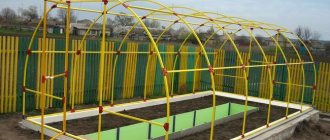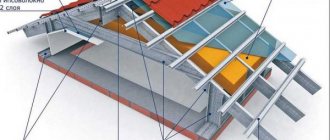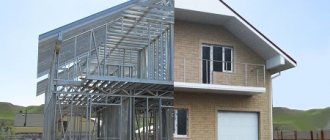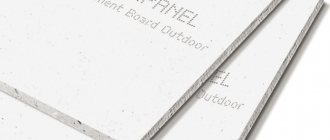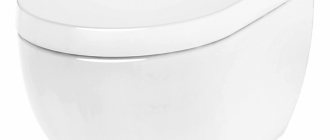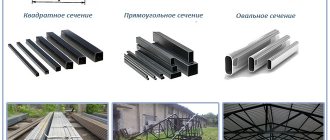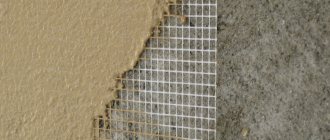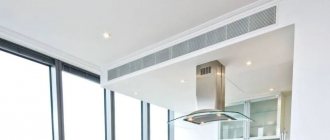A staircase connecting two floors of a building and made of a profile pipe is a fairly popular design today. Like all structures of this type, it is subject to strict requirements for both manufacturing and installation. First of all, it must be safe for moving people of different heights, weights and ages. Let's consider what an interfloor staircase made of a profile pipe is, what aspects you need to pay attention to when making this structure.
Stairs made of profile pipes
General technical characteristics of interfloor stairs
Profile steel pipe is a metal material with high load-bearing capabilities. Therefore, a ladder made from it is a durable and reliable structure that meets all safety requirements. There are other advantages:
- full combination with other materials;
- the ability to carry out different types of finishing;
- Can be used for indoor and outdoor installation;
- installation is carried out at any stage of house construction, even with completed finishing of the premises;
- simplicity of the assembly process.
Many people ask whether a DIY staircase made from a profile pipe will be reliable. The quality of assembly of a staircase structure depends on the experience of the workman, on his skills in working with different tools, where the grinder and welding machine are the main ones. If there are no skills, it is better to place the responsibility of production on the shoulders of the master.
Features of profile stamping
The most obvious difference between profiles from different manufacturers is the individual bending and stamping scheme, which determines the location of the stiffeners and the availability of additional options.
A rack profile, for example, can have a high variety of technological cutouts on the central shelf. By bending the petals, you can create holes for laying communications in the walls, or use the bent elements to temporarily fix the connecting crossbars.
There are also more exotic features: for example, Gyproc profiles have a relief surface, which allows you to do without fastening the racks to the guides, but at the same time the racks are deprived of the ability that many are accustomed to sliding and moving freely inside the guides.
During the process, it will be necessary to frequently cut metal profiles, since they often do not meet the required dimensions. For cutting, it is best to use metal scissors. In any case, you can always connect the profiles, since metal tools strongly resemble parts of a construction set.
Dimensions of stairs
Dimensional parameters are the basis of manufacturing. Therefore, it is necessary to understand what the limitations and requirements for the stairs themselves are.
The staircase made from a profile pipe is based on steps. It is their dimensions that are taken as the basis for the manufacture of the staircase structure. Required parameters:
- tread depth: 20-32 cm,
- tread width: 90-125 cm,
- step height: 14-18 cm.
Dimensional parameters of stair steps
Regardless of the length and angle of inclination of the device, these parameters are strictly adhered to.
Construction drawing
Drawing up a drawing is necessary in order to know what dimensions the frame and cladding elements will be. The diagram will allow you to take into account all the calculations and prevent errors when cutting the material. In addition, using the drawing you can easily calculate the amount of plasterboard material and fasteners for the frame equipment.
To make a drawing you need:
- Measure the length and height of the flight of stairs.
- Determine the size of the steps. The size of the step consists of the width of the tread and the height of the riser.
- A separate calculation and drawing is drawn up for the fence (balustrade). This is carried out if not only the stair stringer or stringer will be sewn, but also the fence.
If you plan to install some additional elements under the stairs or inside the frame, it is recommended to take this into account when drawing up the drawing. Having determined the dimensions, they must be plotted on paper in a convenient scale. You will get a diagram of the frame, according to which you can calculate the dimensions of the sheathing material.
It is necessary to include in the drawing not only the dimensions of the stairs, but also to decide whether there will be something under the stairs or not.
- place of the structure in the house;
- stringers;
- steps;
- supports;
- handrails;
- filling the railings;
- fastening to supporting structures;
- platforms in a multi-flight structure;
- connections to the floor and ceiling.
Types of stairs
There is a fairly wide variety of stairs made from profile pipes, which differ in their approach to purely structural forms and assembly elements. Here are a few varieties.
Staircase with two broken stringers
One of the frequently used options, which has proven its high load-bearing capacity.
Staircase on straight stringers
The model consists of two straight stringers made from a profile pipe. Stepped tread elements made of the same material are installed and fastened on them.
Marching model with one central stringer
This model is one of the most difficult in terms of fitting elements to each other. This requires experience in this type of work. Often, metal stairs with one central stringer made of a profile pipe are used in small rooms. Where you need to save more free space.
With a central broken stringer
A subtype of the previous model, only it uses a broken string rather than a straight one. An interesting option in terms of unusual design and the ability to play on the size of the room.
Let us add that 90° or 180° rotary staircases (with winder steps, intermediate platforms), and screw models are assembled from profile pipes.
Choosing a design
With railings and steps
A staircase in a house can be not only a purely functional element, but also act as some decoration for the room. Therefore, when choosing a design for its design, it is worth considering all the nuances in order to sheathe it as high quality and beautiful as possible. Note! Correctly selected finishing of the staircase will help you hide all its shortcomings. Today, there are the following design options for stairs:
- design with steps and railings;
- design without railings.
Without railings
Depending on the original design of the staircase, its finishing can be done as follows:
- with storage under the steps. A more functional solution, since in such a storage room you can store many different things needed in everyday life. Such a device is only possible when the ladder is extended;
With storage room Without storage room
- no storage room. A simple design option. It is impossible to construct a storage room here, since such stairs have a twisted structure, where each turn is located above the previous one.
Also, instead of a storage room under the steps, you can make a decorative niche, which will give the room a more sophisticated look. As you can see, there are several design options for stairs. And each of them has its own characteristics and functionality. Therefore, before choosing the type of design, consider all the pros and cons of the chosen design.
How to properly design a staircase
The parameters of the steps are known; now they need to be placed in the staircase structure. Therefore, a small sketch is made on a sheet of paper and the necessary calculations are made regarding the number of steps. It is necessary to measure the height of the interfloor ceilings and the angle of inclination of the device.
There are no problems with the latter, because there are standards that are taken as a basis - 25-45°. The height of the stairs is the distance between the already laid floor covering of the first floor and the second.
Dimensions of the staircase structure
Calculation of the number of steps
Look at the photo above, which shows the size of the march length. It is determined by calculating the height of the stairs and the angle of inclination. Both indicators are known. You can calculate the length of the march using the formula indicated in the photo below.
Ratio of triangle sides to angle
For our situation, we need to determine the value of AC. From the lower formula, taking into account mathematical relationships, it is deduced that AC = BC / tan A. Tangent of the angle - table value.
The length of the march is derived by mathematical calculations. Now you need to calculate how many steps will fit on this segment. For example, if the length of the flight is 3 m, and the depth of the steps is 30 cm, then a profile staircase assembled according to these parameters will accommodate 10 steps.
Regarding the height of the steps. It is necessary to divide the height of the stairs by the number of steps. For example, the height of the structure is 2.5 m, divide this figure by 10, we get 25 cm.
Pre-finishing
A staircase covered with plasterboard, with treads and risers installed, must be prepared for finishing. As a rule, water-dispersion paint acts as a finishing coating for gypsum boards. Here are the preparation steps.
Jointing and reinforcement of seams
From the rectangular edges of the parts that were cut off in place, you need to chamfer 2/3 of the thickness of the drywall. The easiest way to do this is with a utility knife. The goal is to allow the putty to penetrate the joint as deeply as possible when filling it.
Seam stitching with a utility knife
The captain is obvious: the semicircular factory edges of the PLUK do not need to be joined.
Then all seams are glued with reinforcing fiberglass mesh with an adhesive layer - serpyanka. Reinforcement will avoid the appearance of cracks at the seams due to changes in the linear dimensions of plasterboard sheets with fluctuations in humidity and temperature.
Reinforcement of an embroidered seam with serpentine
Preparation of putty
Gypsum universal or finishing putty is prepared from a dry mixture immediately before use. The lifespan of the building mixture after mixing with water does not exceed an hour, so it is prepared in small portions (no more than 3-4 kg).
How to do it:
- Pour 1.5 liters of water into a clean and as wide as possible container (for example, a plastic paint bucket);
Try to distribute the plaster evenly over the surface of the water.
- Add 2.4 kg of dry mixture, scattering it as evenly as possible over the surface of the water;
- Allow the plaster to swell for five minutes and mix with a spatula, a construction mixer, or a whisk held in a screwdriver.
In the photo, a drill with a whisk mixer is used for mixing.
Attention: if you pour water into dry plaster, lumps will form at the bottom, which will be very difficult to break during mixing.
Puttying
The seams are puttied in two steps:
- First, the seam is densely filled through the cells of the serpyanka;
- After drying the first layer, the serpyanka is covered with a second one using a wide spatula.
The second layer should hide the texture of the serpyanka
Often, staircase sheathing has to be puttied over the entire surface. The fact is that the seams between the edges of locally cut sheets, thanks to the serpyanka, stand out as thick. If you apply a millimeter layer of putty to the entire finish, the surface for painting will be perfectly smooth.
Puttying gypsum board over the entire surface of the sheet
Finishing touches
After puttying, all we have to do is put a few final strokes on our masterpiece:
- Sanding the putty is done after it has completely dried with a hand float or sander. Be sure to protect your eyes from plaster dust. You need to grind with the light as bright as possible and falling at an oblique angle, which will highlight all the irregularities with a shadow;
Bright lighting at an oblique angle will prevent you from missing surface defects
- Then the staircase filing is swept away from gypsum dust or vacuumed;
- The last stage before finishing is priming the gypsum board with penetrating primer. The type of bonding primer should match the type of paint you choose: latex for latex paint, silicone for silicone, etc.
Acrylic penetrating primer
Manufacturing technology
A staircase made from a profile pipe is a responsible structure. To carry out the work you will need the following tools:
- welding machine,
- grinder with cutting and grinding wheel,
- locksmith's square,
- tape measure, ruler, pencil.
Let's look at how to properly assemble a device based on broken strings. To do this, it is necessary to make blanks of material that define the parts of the stringer structures. There are two of them: to suit the size of the step and the riser. The parameters are derived mathematically from the calculation of the height and angle of inclination of the stairs.
Regarding the pipe profile. It is better to choose a section of 80x40 or 80x80 mm with a wall thickness of 3 mm. Let’s make a reservation right away: it is better to join the pipe elements together at an angle of 45°. A right angle joint is not maximally load-bearing. But this is not a strict requirement, because small interfloor metal stairs can easily withstand the weight of 1-2 people.
Chopped parts of the stringer
The required number of elements are cut from a profile pipe of the selected size using a grinder. Supports for steps and risers are cut separately. Their number is multiplied by “2” at the rate of two broken stringers.
Joining two elements
From waste material, you can weld a special device - a 90° jig, with the help of which two elements of the stringer are joined. This is where the welding work begins - tack welding of two pipes.
Two elements welded together
Next, the joined parts are completely scalded around the perimeter of the joint and polished with a grinder so that there are no metal smudges or burrs left at the joint.
Ready stringer
The next stage is joining the blanks into a finished product - a stringer. It is carried out using identical technology for joining and welding individual pipes.
Rules for assembling the second stringer
The second stringer is easier to assemble. It is necessary to lay the first one on a flat area, on it sequentially, starting from the edge of the structure, lay and join the semi-finished products. Make tack welding immediately on the spot. After which the joints are completely scalded and polished. Don’t forget to check the joints with a plumber’s square.
The next step is very important. It is necessary to connect two stringers into a single staircase structure (frame). To do this, install pipe sections from a profile with a cross-section of 20x40 mm and a thickness of 2 mm between them, the length of which is equal to the width of the step. Therefore, the crossbars are first cut to length using a grinder, after which the stringers are set in parallel and connected by the cut out elements. The crossbars are supports for the steps. The frame is ready, installation can be carried out.
Stringers connected by crossbars
Watch the video: how to assemble a staircase from a profile pipe on two broken stringers.
Fastening the ladder at the installation site
There are many options for attaching a staircase structure (frame) to the floor of the first floor and the ceiling of the second floor. It’s easier with a ground floor base. A simple option is to drive metal pins into the base, to which the stringers are welded. You can place an embedded part in the form of a rectangular metal sheet into a concrete screed, and the staircase is welded to it.
Regarding the floor slab of the second floor, there are also several simple options. One of them is shown in the photo below. It clearly shows that the top last step lies on top of the floor of the second floor, and the stringer is attached to the end of the slab with metal anchors. To do this, a rectangular metal plate is welded at its end.
Fastening a metal stringer from a profile pipe to the ceiling
Sheathing with plasterboard
How to cover a staircase with plasterboard on a finished wooden frame?
Cutting parts
Drywall is cut along curves or broken lines with a narrow hacksaw with medium teeth or, which is much faster, with a jigsaw with a wood saw. The teeth of the file should be directed upward, towards the sole of the jigsaw, otherwise the tool will be pushed away from the cut, and it will turn out uneven.
Parts of complex shapes are cut out with a hacksaw or jigsaw
Attention: when cutting, a large amount of dust rises into the air, which then settles on all accessible surfaces. The room must be cleared of furniture and household appliances, the doors to adjacent rooms must be securely closed and, if possible, all windows must be opened.
Along straight lines, it is more convenient not to saw the gypsum plasterboard, but to break it, having previously cut it by a quarter to a third of the thickness.
The step-by-step instructions look like this:
- Mark the edge line;
- Press a steel ruler, corner or profile along the marking;
- Draw the plasterboard along the ruler with a knife several times;
The cut sheet will break off exactly according to the markings
- Place the sheet with the cut on the edge of a table or other elevated surface (for example, on a stack of sheets of drywall waiting for their turn) and break it off;
- Cut off the cardboard shell from the back;
- If there are any protrusions on the edge that are bothering you, remove them with a plane.
Fastening
How to cover a gypsum board staircase with your own hands? It’s very simple: the parts cut in place are attached to the wooden frame with phosphated self-tapping screws 25 mm long. You can use self-tapping screws for both drywall and wood: their price is the same, and the differences come down only to different thread pitches.
Self-tapping screws for drywall (1) and wood (2)
However: with a two-layer sheathing, the second layer is mounted with 40 mm fasteners.
A few subtleties:
- The step between the fastening points should not be more than 20 cm on vertical surfaces and 15 cm when hemming the span from below;
- Self-tapping screws should not be screwed in closer than a couple of centimeters from the edge of the sheet, otherwise it may crumble;
- When screwing several self-tapping screws into a block at a minimum distance from each other, they should be arranged in a snake pattern so as not to split the wooden frame element along the grain.
The finishing of a staircase opening in a stone house is often done without a frame: gypsum board is glued to the walls using gypsum mounting adhesive. It is successfully replaced by gypsum putty.
The fastening process is very simple: the glue is applied in beads to the sheet itself or to the walls of the opening, after which the gypsum board is pressed against the walls and leveled according to the rule or long level with light blows.
Fastening gypsum boards in the opening with glue
Photo gallery
180° rotatable staircase on two broken stringers made of profile pipe
An economical option, original with wide steps and well-designed and installed railings
A structure with a 90° rotation on two stringer supports with an original fence made of profile pipe and square reinforcement
A complex staircase with several turns, winder steps, landings on one stringer made of a profile pipe
Staircase structure made of profile pipes: stringers and railings
Fastening the frame
Carrying out work on covering a metal staircase is a very meticulous process that requires precision and attention. Work should begin with the assembly of the metal frame, which will provide the “skeleton” of the staircase. Installation of the frame is simple, but requires precision and attention. Stages of work:
- Using the drawing as a guide, mark the floor. It is necessary to initially lay all planned niches and storage rooms in the frame;
- Install a stringer and frame frame around the entire perimeter. Secure with dowels every 8-10 cm;
- Raise the frame to height. To do this, insert rack rails with transverse slats into the frame frame, which will mark steps or a balustrade;
- Connect the vertical posts to the frame frame. This will increase the rigidity of the structure.
After assembling the frame is completed, you need to clean it from dust and debris, remove rough edges and be sure to degrease it. If you want to increase the degree of sound insulation of the stairs, then lay a layer of felt or underlay on the surface.
Choosing tools
To sheathe a staircase with your own hands from a set of tools you will need:
- screwdriver or drill with a set of drills;
- building level;
- tape measure, regular pencil and marker;
- corners;
- plumb lines and ruler;
- interlining;
- set of spatulas;
- metal scissors and a knife for working with drywall.
If you are short of a tool, you can always ask your friends, neighbors, or buy it at a hardware store. From the list of materials you should have on hand;
- sheets of plasterboard or other finishing material;
- metal profiles. To create a frame, you can also use wooden slats;
- fastening elements - self-tapping screws, dowels, screws;
- serpyanka;
- putty;
- primer.
After preparing the necessary materials and tools, you can begin finishing the stairs.
Formation of arches
The bend is created using a special arched profile. If it is not available, you can use a flow guide: cutouts in the form of petals are made in the side walls, after which it is easily bent.
Both guides are connected by vertical posts, to which drywall is subsequently attached.
With an arch width of up to 30 cm, horizontal jumpers are optional: the necessary rigidity will be provided by the bottom plane of plasterboard.
Do-it-yourself staircase from a profile pipe: profile selection and assembly
Where reliability and durability are needed, metal is always present.
Moreover, the more massive the metal, the stronger it is. However, when designing and assembling stairs, excessive massiveness can do a disservice. And instead of an elegant and durable structure, you will end up with a massive, heavy and very angular staircase, into which you will also have to invest money to bring this statue to some acceptable option. In order to avoid unnecessary expenses, and initially find a golden mean in resolving the issue, we have prepared these instructions.
Designing stairs is a responsible business for passionate people
Scope of use
The winder staircase can be used not only in private houses and cottages. It will also be useful in public buildings and industrial facilities. The main advantage of such structures is their compact size. Despite their small dimensions, they allow you to conveniently climb to the floor.
Winder stairs are also used as escape routes. However, you need to know that it will be difficult to lift or lower large objects from the floor. If there is no other way to transport such items, then this circumstance must be taken into account when designing the stairs.
The final stage
After all the above steps have been completed, we install the railing and carry out the final finishing:
- We glue serpyanka onto the joints of the slabs, and treat the corners with non-woven material;
- We putty all the joints of the plates and screw in the screws;
- We clean out all the irregularities and prime the structure.
Now you can give your DIY staircase its final appearance. Most often it is painted with dark or light paint colors, depending on the color scheme of the interior, or finished with wood and artificial stone. You can also use gypsum stucco. By following the instructions above, finishing the stairs will be done quickly, efficiently and efficiently. It can become a real treasure of your interior, and the result will satisfy you 100 percent. And all this will be possible thanks to the unique properties of plasterboard, which is excellent for finishing.
There are a number of issues to consider. After all, a flight of stairs is not only the shortest and most convenient way to move between floors, but also an element of interior design. Therefore, it is very important to consider the type of finishing of the flight of stairs when designing. An incorrectly selected finishing material will not only lead to disharmony in the home’s decor, but will also make your home uncozy. This especially applies to stairs made of concrete.
Properly selected cladding of the structure will not only give a unique look to the house, but will also allow it to serve for a longer time. At the same time, you will not be exposed to danger, you will not have to be distracted by premature repairs and experience discomfort.
Door (window) opening
If the partition has a door, then a gap of the appropriate length is made in the lower guide. Then they proceed according to the following scheme:
- The racks adjacent to the doorway are aligned vertically using a level. They are attached with self-tapping screws to the frame guides and then reinforced with wooden beams.
Note! The distance between the posts forming the doorway should be 2 cm greater than the width of the frame.
- The upper jumper from the guide profile is installed. It should be located 1–1.5 cm above the future door structure.
- An additional vertical post, cut to size, is attached to the gypsum board joining line above the door.
The window opening in the partition is made in a similar way, only another horizontal lintel is added at the bottom.
USEFUL INFORMATION: Installing drywall on a wall without a frame
Ceiling leveling
The structure of the ceiling frame is similar to the wall one and follows the same principles. Distinctive points:
- In addition to straight ones, extended hangers can also be used, especially for multi-level structures.
- Ceiling profiles are used. Most often, they form a kind of grid that allows you to attach drywall in a checkerboard pattern.
- The pitch between the hangers is 40–60 cm. Reducing it helps prevent sagging of the structure.
- It is convenient to control the position of the supporting profiles using cords stretched between the walls.
- At the intersections of frame elements, “crab” type connectors must be used.
The process of assembling a shelf frame for drywall is described in more detail in this article.
Step cladding
As a facing material for the steps of a concrete staircase, tiles, preferably with an anti-slip coating, made of porcelain stoneware or clicker materials, are ideal. Such tiles most often represent ready-made steps. Finding the right shape and size is not difficult. It is now quite common on the market. This material is best combined with skirting boards mounted on both sides.
Before starting work, all cracks, crevices and chips of the concrete staircase are eliminated using cement-sand mortar or self-leveling floor. The actual cladding of straight flights of stairs must begin from the bottom step. The procedure for finishing with porcelain stoneware is very simple and is no different from simply laying tiles. After completely laying the tiles, it is necessary to grout all the seams to give an aesthetic appearance. Of course, you can call professionals for such work, but even an ordinary person can handle it.
We construct a balustrade
The balustrade is not only a decorative decoration for the staircase, but also serves as a safety element, especially for children. Usually it is designed only on the side that faces the observer. The second side can simply be finished with any material you like.
Balustrade on the stairs
The installation of such an element is also determined by the angle in which the structure stands, what kind of interior there is, etc. Therefore, in some situations there is no need to make a balustrade. In the absence of a balustrade, the corners of the structure are closed with a perforated corner.


